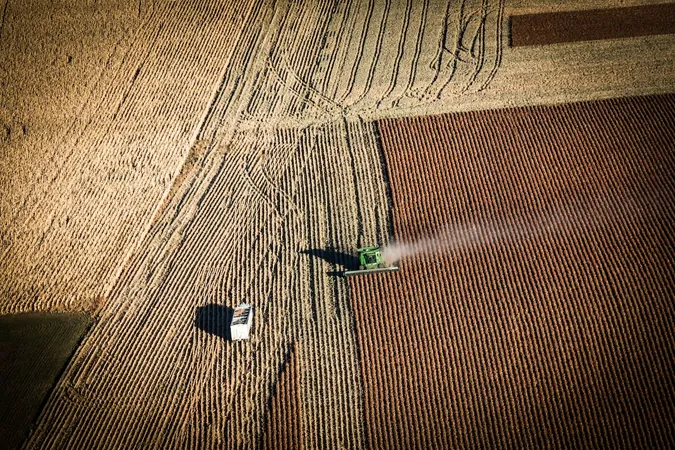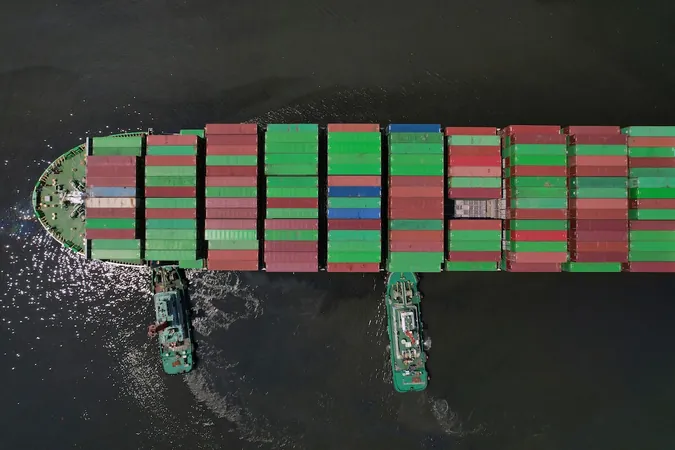
South Dakota Farmers: Between Tariff Turmoil and Hope
2025-04-12
Author: Jacques
Farming in the Era of Automation
Meet Tanner Hento, a South Dakota farmer who often lets his high-tech tractor do the heavy lifting. Thanks to autonomous technology, he can simply start the machine, leave, and return hours later to find his work done. But while the tractor handles the tilling, Tanner is grappling with an entirely different challenge: the impact of President Trump's tariffs on his livelihood.
A Trade War's Heavy Hand
Farming communities like Avon, South Dakota, historically unremarkable, are now thrust into the global spotlight due to the trade war. With nearly half of U.S. soybeans destined for international markets, a staggering one-third is consumed by China. Tanner laments, "This trade war feels like the Titanic hitting an iceberg—we're sinking fast." Although the tariffs threaten immediate financial stability, farmers are holding on to a glimmer of hope.
An Optimistic Outlook Amidst Uncertainty
Despite the looming tariffs, farmers like Tanner remain cautiously optimistic. Most inputs for this year's crops, including seeds and fertilizers, were purchased ahead of time. He believes the long-term benefits could ultimately favor improved trade relations. However, many are left wondering how far-reaching the tariffs will be.
Political Dynamics and Agricultural Dependence
As farmers endure this challenging phase, Trump's agricultural base remains surprisingly loyal. Mike Lauritsen, a local Republican figure, notes that if Trump's trade policies lead to resurgent manufacturing and better prices, he could be heralded as a transformative leader, akin to Reagan. Yet, the potential long-term damage to farmers—his staunchest supporters—poses a political conundrum.
Mitchell's Balancing Act: Progress Meets Anxiety
In Mitchell, South Dakota, where agriculture fuels the local economy, a state-of-the-art $500-million processing plant is in the works, poised to elevate soybeans and other crops. Yet, as uncertainty looms over trade, local tourism parties worry about keeping Canadian tourists coming. The stakes are high for the local economy, which relies heavily on agricultural exports.
Awareness and Action in State Politics
As farmers try to ride the wave of optimism, politicians approach the tariffs with concern. State representative Erik Muckey warns that the tariffs could devastate South Dakota's economy, already reliant on federal spending. Local leaders express the need to monitor these developments closely, emphasizing their potential fallout on a historically Republican state.
Navigating a Global Economy
With political figures such as former Governor Kristi Noem now positioned in Washington, South Dakota is uniquely situated at the crossroads of policy. Yet, as retaliatory pressures surface, the agricultural sector, especially the soybean market, must remain agile to survive.
Farmers' Perspectives: A Dual Reality
For farmers like Scott VanderWal, the tariffs have already begun to pinch. He's sitting on unsold crops as prices fluctuate drastically. Yet, he shares a sentiment that resonates among his peers: a belief in the necessity of the tariffs as a protective measure for American interests. Contributors to the agricultural sector foresee a need for rebalancing trade relations, willing to bear short-term pain for long-term gain.
Finding Balance Between Protectionism and Prosperity
Brett Kenzy, a rancher, emphasizes that the view of tariffs as adversarial is simplistic; it's more of a repositioning towards equitable trade relations. He's willing to endure financial strains that may result from protectionist policies, advocating for a stronger domestic economy that's not tethered to foreign dependencies.
While uncertainty lingers, South Dakota farmers remain resilient, striving to navigate the turbulent waters of global trade with hope for brighter days ahead.









 Brasil (PT)
Brasil (PT)
 Canada (EN)
Canada (EN)
 Chile (ES)
Chile (ES)
 Česko (CS)
Česko (CS)
 대한민국 (KO)
대한민국 (KO)
 España (ES)
España (ES)
 France (FR)
France (FR)
 Hong Kong (EN)
Hong Kong (EN)
 Italia (IT)
Italia (IT)
 日本 (JA)
日本 (JA)
 Magyarország (HU)
Magyarország (HU)
 Norge (NO)
Norge (NO)
 Polska (PL)
Polska (PL)
 Schweiz (DE)
Schweiz (DE)
 Singapore (EN)
Singapore (EN)
 Sverige (SV)
Sverige (SV)
 Suomi (FI)
Suomi (FI)
 Türkiye (TR)
Türkiye (TR)
 الإمارات العربية المتحدة (AR)
الإمارات العربية المتحدة (AR)